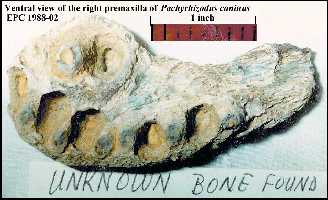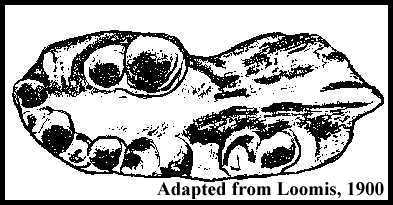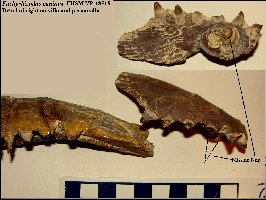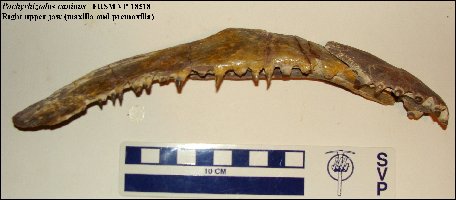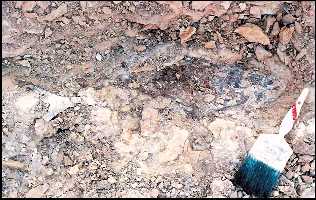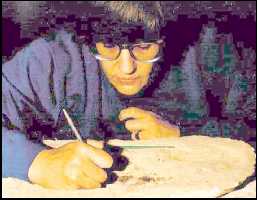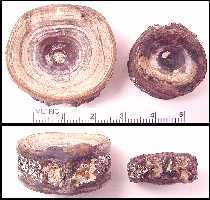 |
Pachyrhizodus
A Large Predatory Fish from the Late Cretaceous
Western Interior Sea
Copyright © 2003-2013 by Mike Everhart
Created 11/11/2003; Last update 07/01/2013
LEFT: Two Pachyrhizodus caninus
on the hunt. Paleo-art by Ron Garrett; Copyright © Ron Garrett 2004.
Used with permission. |
Pachyrhizodus is the genus of medium sized (up to 3m) Late Cretaceous
fish found in the Smoky Hill Chalk. First named by Agassiz from specimens
collected from the English Chalk, E.D. Cope later named two new species from
Kansas (P. caninus and P. leptopsis). A much smaller member of the
genus, Pachyrhizodus minimus, was added by Albin Stewart in 1899.
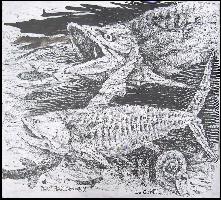 |
The remains of a least three species of Pachyrhizodus
are fairly common finds in the Smoky Hill Chalk of Western Kansas. Two of the species, Pachyrhizodus
caninus and P. leptopsis were medium sized predators, up to 6 ft (2m) or
more in length. They have large teeth which can be easily confused with those of mosasaurs
(see Stewart and Bell, 1994). The third species, P. minimus, probably grew no
larger than 3 ft (1 m). For unknown reasons, P. minimus is often preserved
as a complete fish, in some cases with the remains of internal organs and scales. LEFT:
Pachyrhizodus. Paleo-art by Ron Garrett; Copyright © Ron Garrett 2004. Used with permission. |
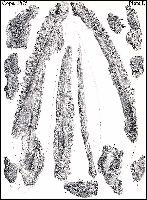 |
LEFT: (CLICK TO ENLARGE) Pachyrhizodus caninus Cope 1872:
Plate L (50) from Cope (1875), The Vertebrata of the Cretaceous Formations of the
West. Cope's illustration shows the heavy lower jaws and large teeth that are typical
of this species.
RIGHT: The lower jaw and left quadrate of a new Pachyrhizodus caninus
specimen from the
Smoky Hill Chalk (FHSM VP-18518).
|
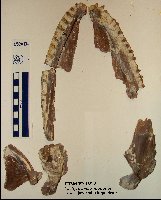 |
We found our first Pachyrhizodus caninus remains (a very scattered
skull and lower jaws) in the low chalk of Ellis County in 1988 and were really
puzzled trying to figure out what they were.
In a bit of an understatement, Cope (1872) describes the premaxillary bones of Pachyrhizodus
as being "well-developed." Since then, we've found a number of similar
specimens, and it seems that the anterior end of one premaxilla or the other is almost
always among the remains.
 |
LEFT: A left premaxilla and a fragment of the right dentary of a
badly broken and poorly preserved skull of Pachyrhizodus caninus (EPC 1991-18).
(Smoky Hill Chalk, Gove County) RIGHT: A close-up of the fragment of
the right dentary showing a complete tooth and the roots of three other teeth (EPC
1991-18). |
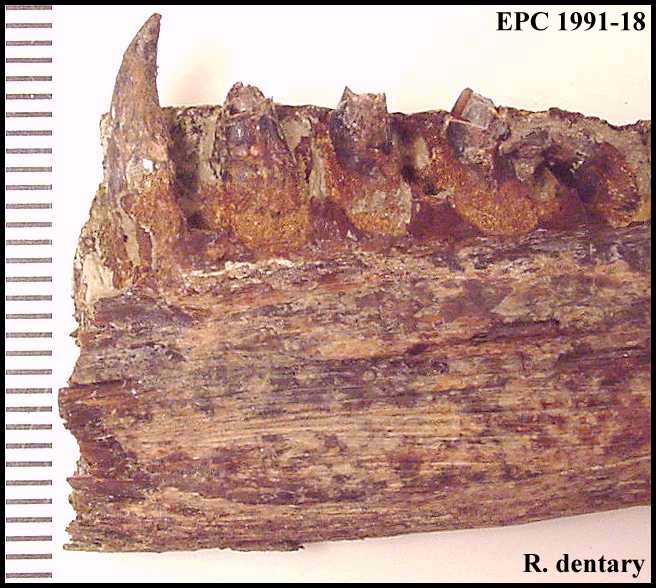 |
| The first specimens of Pachyrhizodus
caninus were apparently found by E. D. Cope while in western
Kansas in 1871, mentioned briefly in his 1872 note "On the families
of fishes of the Cretaceous formation in Kansas," and described more
fully by him in 1875. He noted that the skull of one specimen was "about a foot in
length by 6 and a half inches wide." The remains were found in Fossil Springs
Canyon, south and east of Fort Wallace (Logan County).
Pachyrhizodus minimus, was described from a lower jaw found by Alban Stewart in 1899
near Butte Creek in Logan County. As its name implies, it is a much smaller fish than P.
caninus. Since then, numerous examples of complete fish of this species have been
found in the chalk Miller (1957) reported on a specimen (FHSM VP-326) with preserved
intestinal casts found by George Sternberg near Hackberry Creek in SW Trego County. - Photo of specimen in the Sternberg Museum)
In 1990, while we were collecting with J. D. Stewart
in Lane County, my wife Pam found a nearly complete P. minimus eroding from the
chalk. The chalk at this site is somewhat older than that of the type locality
(Santonian). J. D. and I uncovered the specimen and then put a plaster jacket over it (See
below) . |
SYSTEMATIC PALEONTOLOGY Class Osteichthyes
Infraclass Teleostei
Superorder Elopomorpha
Order Elopiformes
Suborder Elopoidei
Family Pachyrhizodontidae Cope 1872
Genus Pachyrhizodus Agassiz 1835 (in Poissons Fossiles)
Pachyrhizodus caninus Cope 1872
Pachyrhizodus leptopsis Cope 1874
Pachyrhizodus minimus Stewart 1899
|
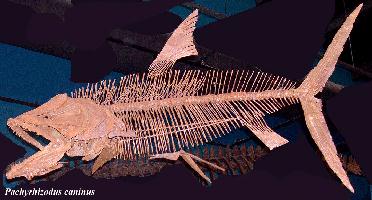 |
The heavy, toothy jaws of Pachyrhizodus leptopsis Cope
1874 have been responsible for some confusion among paleontologists. Specimens from
the Late Cretaceous (Cenomanian) of Texas were described by Stenzel (1944) as very early
mosasaurs. Thurmond (1969) described a specimen as the jaw of an early mosasaur.
Stewart (1989) and Stewart and Bell (1994) showed convincingly that the jaws originally
described as being from the earliest mosasaurs in North America actually came from Pachyrhizodus
leptopsis. In that regard, Martin and Stewart (1977) reported that the earliest known
North American mosasaurs are actually from the Fairport Chalk Member (Middle Turonian) of
the Carlile Shale in Kansas. LEFT: A Pachyrhizodus caninus
at the Rocky Mountain Dinosaur Resource Center. |
The heavy, toothy jaws of Pachyrhizodus leptopsis Cope 1874 have been
responsible for some confusion among paleontologists. Specimens from the Late
Cretaceous (Cenomanian) of Texas were described by Stenzel (1944) as very early mosasaurs.
Thurmond (1969) described a specimen as the jaw of an early mosasaur. Stewart (1989)
and Stewart and Bell (1994) showed convincingly that the jaws originally described as
being from the earliest mosasaurs in North America actually came from Pachyrhizodus
leptopsis. In that regard, Martin and Stewart (1977) reported that the earliest known
North American mosasaurs are actually from the Fairport Chalk Member (Middle Turonian) of
the Carlile Shale in Kansas.
 |
LEFT: The skull of a very large Pachyrhizodus caninus
specimen (FHSM VP-2189) in collection of the Sternberg Museum of Natural History. The
skull is 56 cm (22 in) long. RIGHT: A close up of the jaws and teeth
of VP-2189; the lower jaw measures 52 cm (20.5 in.) and the largest teeth are 4 cm (1.6
cm) tall. |
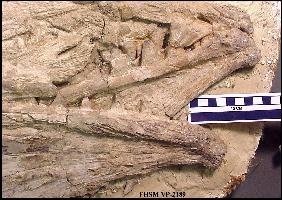 |
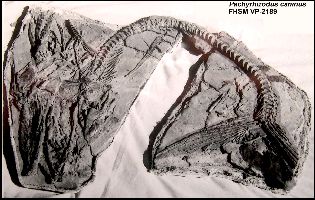 |
LEFT: An early photograph of the large Pachyrhizodus caninus
(FHSM VP-2189) collected by Orville Bonner in December, 1965, from the Greenhorn Limestone
near Russell, Kansas. A note with this picture indicates that specimen is 8.5 feet (2.6 m)
long. |
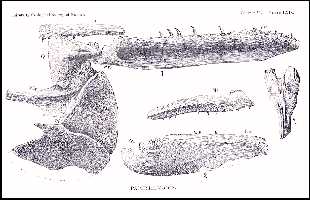 |
LEFT: Plate LXIX from Stewart, 1900 showing the lower jaw and
partial skull of Pachyrhizodus. RIGHT: The lower jaws of Pachyrhizodus
minimus from Stewart, 1899. This is the holotype specimen (KUVP-327) in the
collection of the University of Kansas. |
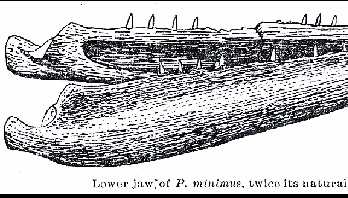 |
A DIG FOR A COMPLETE PACHYRHIZODUS MINIMUS
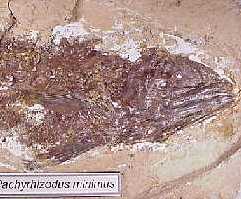 |
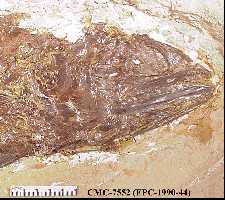 |
Close-ups of the skull and pectoral fins of CMC 7552 |
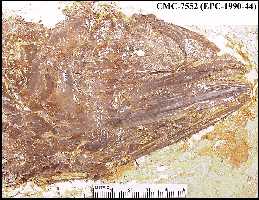 |
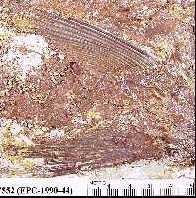 |
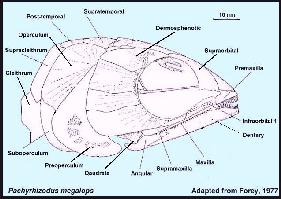 |
LEFT: A reconstruction of the skull of Pachyrhizodus megalops (Woodward)
from the English Chalk (Turonian). Adapted from Forey, 1977. This species is similar
to P. minimus from the Smoky Hill Chalk. |
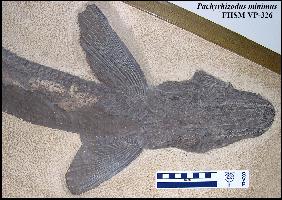 |
LEFT: A close up of the Pachyrhizodus minimus (FHSM
VP-326) described by Miller (1957) - Currently on exhibit at the Sternberg Museum. Click here for a large picture of the complete
specimen. RIGHT: A large specimen of Pachyrhizodus caninus
in the collection of the University of Kansas. (Scale = cm) |
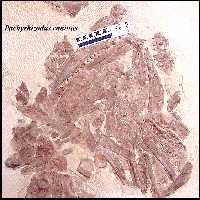 |
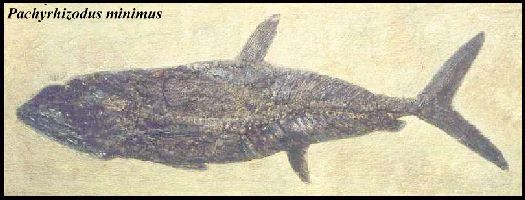 |
LEFT: A complete Pachyrhizodus minimus from the Smoky
Hill Chalk of Kansas on exhibit in the Denver Museum of Nature and Science. (Size is about
3 ft / 1 m) |
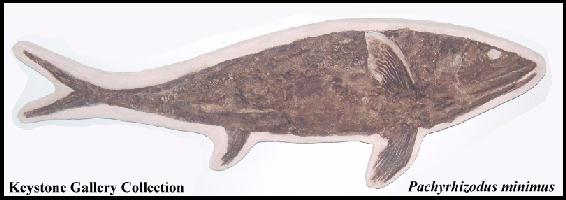 |
LEFT: A complete specimen of Pachyrhizodus minimus in the
Keystone Gallery collection. |
Other
Oceans of Kansas webpages on Late Cretaceous fish:
Field Guide to Sharks and Bony
Fish of the Smoky Hill Chalk
Sharks:
Kansas Shark Teeth
Cretoxyrhina and Squalicorax
Ptychodus
Chimaeroids
Bony Fish
Pycnodonts and Hadrodus
Plethodids:
Pentanogmius
Martinichthys
Thryptodus
Bonnerichthys
Protosphyraena
Enchodus
Cimolichthys
Pachyrhizodus
Saurodon and Saurocephalus
Xiphactinus
SUGGESTED REFERENCES:
Agassiz, J.L.R. 1833-1844. Recherches sur les Poissons Fossiles. 3:
pp. vii + 390 + 32, Neuchątel and Soleure.
Cope, E. D. 1872. On the fossil reptiles and fishes of the Cretaceous rocks of
Kansas. Art. 6, pp. 385-424 (no figs.) of Pt. 4, Special Reports, 4th Ann. Rpt., U.S.
Geological Survey Territories (Hayden), 511 p.
Cope, E. D. 1872. Note of some
Cretaceous vertebrata in the State Agricultural College of Kansas. Proceedings of the
American Philosophical Society 12(87):168-170. (for Oct. 20, 1871 meeting)
Cope, E. D. 1872. On the families of fishes of the Cretaceous formation in Kansas.
Proceedings of the American Philosophical Society 12(88):327-357.
Cope, E. D. 1875. The vertebrata of the Cretaceous formations of the West.
Report, U. S. Geological Survey Territory (Hayden). 2:302 p, 57 pls.
Dixon, F. 1850. Geology and fossils of the Tertiary and Cretaceous
formations of Sussex. pp. i-xvi; 1-422.
Forey, P. L. 1977. The osteology of Notelops Woodward, Rhacolepis
Agassiz and Pachyrhizodus Dixon (Pisces: Teleostei). Bulletin of the British
Museum (Natural History), Geology, 28(2):125-204.
Hay, O. P. 1903. On certain genera and species of North American Cretaceous
actinopterous fishes. Bulletin American Museum Natural History XIX 1-95, pls. i-v, 72
text-figs.
Jordon, D. S. 1924. A collection of fossil fishes in the University of Kansas from the
Niobrara Formation of the Cretaceous. University Kansas Science Bulletin, 15(2): 219-245.
Loomis, F. B. 1900. Die anatomie und die verwandtschaft der
Ganoid- und Knochen-fische aus der Kreide-Formation von Kansas, U.S.A. Palaeontographica,
46:
Martin, L. D. and J. D. Stewart. 1977. The oldest (Turonian) mosasaurs
from Kansas. Journal of Paleontology 51(5):973-975.
Miller, H. W. 1957. Intestinal casts in Pachyrhizodus, an Elopid fish,
from the Niobrara Formation of Kansas. Kansas Academy of Science, Transactions
60(4):399-401.
Stewart, A. 1898. A preliminary description of seven new species
of fish from the Cretaceous of Kansas. Kansas University Quarterly 7(4):189-196, pl. XVII.
(Protosphyraena recurvirostris sp. nov., Enchodus parvus sp. nov., Enchodus
amicrodus sp. nov., Pachyrhizodus leptognathus sp. nov., Pachyrhizodus
velox sp. nov., Beryx polymicrodus sp. nov. and Beryx multidentatus
sp. nov.)
Stewart, A. 1899. Pachyrhizodus minimus, a new species of
fish from the Cretaceous of Kansas. Kansas University Quarterly 8(1):37-38.
Stewart, A. 1900. Teleosts of the Upper
Cretaceous. The University Geological Survey of Kansas. Topeka VI 257-403, 6 figs., pls.
XXXIII-LXXVIII.
Stewart, J. D. 1989. The earliest reputed North American mosasaur records are not
mosasaurs. Journal of Vertebrate Paleontology (Abstracts) 9:39A.
Stewart, J. D. and G. L. Bell, Jr. 1994. North America’s oldest
mosasaurs are teleosts. Contributions to Science, Natural History Museum of Los Angeles
County, 441:1-9.
Credits: Earl Manning, Tulane University provided references and comments
on the content of this webpage.





